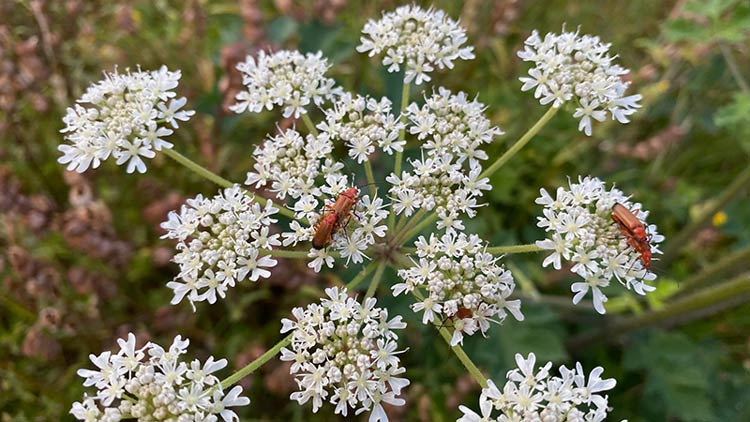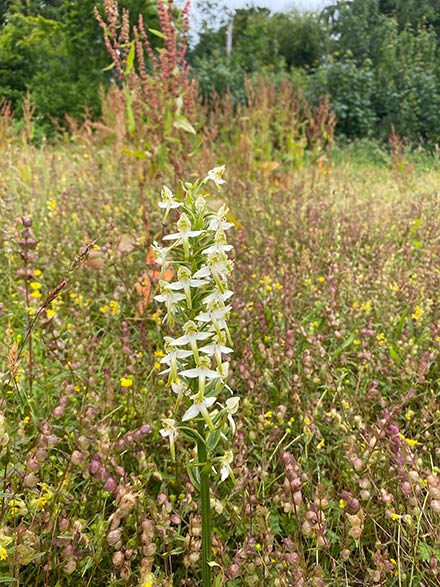- Regular Price
- £19.99
- Sale Price
- £19.99
- Regular Price
- £19.99
- Unit Price
- per

One of my earliest childhood memories is taking myself off for adventures, spending all day ‘fishing’ for Sticklebacks in a small stream or on hot summer days, I might alternate my adventures with tree climbing or lazing in wildflower meadows.
I would walk into the middle of the field, lie down on my back and watch the clouds scudding across the sky. I would be surrounded with wildflowers, which of course I would just see as flowers, but it was the myriad of tiny creatures that really got my attention. Lying in my concealed mini world for hours, watching small flying insects zipping overhead, multi-colour hairy caterpillars mindfully munching their way through leaves, the buzzing sound of pollinators as they scouted from flower to flower. Such a strong and lovely memory. But that’s the problem, it really is a long-ago memory.
A recent family holiday in France, deep into the foothills of the Pyrenees, brought me back to that time all those years ago – here were the flower meadows I had long forgotten – ablaze with flowers, and so loud with buzzing insects.
Back in Cornwall, we did have a small field, but it had sheep on it and it had not occurred to me that we could bring wildlife back to our own corner of the world.
Four years ago, we were invited to visit Lethytep Wildlife Haven, about 10 miles from us, near the south coast of Cornwall. Philip and Faith Hambly have spent the past 15 years of their retirement creating a wildlife haven on their 52 acre farm, including flower meadows, wetlands, ancient woodland and several natural spring fed lakes.

Walking through their fields in June, on one of their few open days, we were greeted by clouds of butterflies as they rose into the air as we walked down the mown pathway whilst flocks of finches and linnets would rise on either side as we passed by. The lakes are a magical home to dragonflies and damselflies in every possible colour combination, resting on the huge abundance of different water lilies. If we were lucky, we might get to glimpse the occasional bright blue and orange streak that is their resident kingfisher. If you are ever in Cornwall in June or July, do try and visit this remarkable place – which is utterly beguiling.

And then there are the cakes…I mean truly amazing cakes!
We had one field of about 2 acres. Philip was kind enough to spend time talking us through how to start our meadow, whilst I ate my way through four quite large pieces of home-made cake, curtesy of Faiths’ baking genius. Philip Even in his is one of those rare people who draw you in with their sheer exuberance and enthusiasm; you can’t help but get excited by way of osmosis. He is unstoppable, with his boundless energy he is consumed by the desire to educate everyone he can to the joy of the wild.
We collected yellow rattle seed from his fields and sprinkled it by hand over the top part of our field. Philip was confident that in a few years the yellow rattle would have covered the field. I wasn’t so sure. The next Spring, I walked the field every day, obsessively searching for any sign of the Rattle. Eventually, spotting something that I hadn’t seen before, I realised it was everywhere that we had scattered the seeds. The yellow rattle is mildly parasitic to grass; it doesn’t kill it but weakens it allowing the more fragile natural a chance of growing.
Within a few months, the top of the field was covered with the pretty yellow flowers and was humming with bees, flying insects and butterflies. The swallows that arrive here like clockwork on the 6th April, were in for a treat as the field was awash with critters. And our first Southern Marsh Orchids appeared. In the Autumn the field was cut for beautiful smelling hay. The sheep came back in over the winter and early Spring for short periods, loving all the interesting new plants.

The second year started as before except, as Philip had predicted, the Yellow Rattle had spread! Everywhere, except the furthest reaches of the field. More Southern Marsh Orchids, plus a new one – a Lesser Butterfly Orchid – just one. We also began to see knapweed, red clover, Devil’s-bit Scabious, Dandelions, Buttercups, Cow Parsley, Greater Stitchwort & Red Campion. We saw more bats too, skittering around the twilight sky.
The field is now completely covered in Yellow Rattle.

We had an exciting new arrival; the Greater Butterfly Orchid, standing proudly all on its own and looking magnificent. After my daily routine walk around the field, I would just go and sit and ‘hang out’ with it. We now had many more of the Lesser Butterfly Orchid and the Southern Marsh Orchid.


And the poppies! Only two or three at a time, but there they were, rising above the rest of the plant family, resplendent in their papery red petals. We also had huge swathes of Birdsfoot Trefoil. This had spread into huge clumps, with its beautiful orangey-yellow flowers.
One evening on my daily round I saw clouds of Common Blue butterflies explode out of the clumps as I drew near. They were everywhere – I had rarely seen any of these butterflies over the past 20 years of living here. But here they were in their hundreds! Such delicate patterning. What a privilege.

We now seem to have a posse of four roe deer too that hang out in the woods for much of the day, and ‘pop’ out in the early evening to graze.
The excitement of seeing this extraordinary regeneration of wildlife in such a short period, made me look at our garden in a different way too. We had several small areas of ‘wasteland’ – which comprised of stinging nettles, docks and brambles. One was only 8 feet x 1ft, which I thought we could do something with. I bought a packet of purely meadow flowers (so no grasses). We dug the areas over and pulled out the deep-rooted weeds and simply raked the area over. I threw the seeds around as best I could and re-raked it and sprayed it with the hose. Job done. And within a few weeks the magic began.


The meadow flowers grew taller and filled out the space then began to flower. It was heavenly, the most beautiful colourful flowers that seemed to blend so well with each other. Along came the butterflies, bees, hoverflies, wasps, and even a Hummingbird hawk moth and many other flying creatures. And very late in the season, I found little un-packed lunches made by mice, who had been having feasts under the canopy of their meadow trees.
The flowering continued unabated through late summer and autumn. We even had cornflowers in bloom in January this year - perhaps a sad indicator of climate change.
I have collected the seeds and thrown them around the field in the last few weeks. I will do minimal work to these areas again, disturbing the soil as little as possible and will sow seed as before.
This shows that you don’t need a huge area – even those patches you have side-lined from the patio or garden as they are ‘too difficult’ can, without spending a fortune, be truly magnificent.
There are many wildflower mixes available. The one I chose had so many different varieties of seeds, including, I feel one of the most important for insects, Phacelia, which the insects go crazy over, and it flowers non-stop for months on end. We also had Cornflower, Corn Marigold, Corncockle, Dwarf sunflower (we got just one of these in the pack), Yarrow, Scabious, Oxeye Daisy, Marjoram, Selfheal, Wild Carrot and Salad Burnet, plus others in the one packet of seeds.
Below, you can see the Yellow Rattle has now matured and the dried seed heads make their eponymous rattling sound as we wander through the field...

I am happier admiring nature's wonders - and being behind the camarea, photgraphing than being photographed!
The garden wildflower patch was so little effort with so much reward, we hope you feel enthused to have a go and enjoy...
6 comments
do you still sell embroidery frames?
What a lovely message to send out during this stormy weather. Thank you!
That is absolutely beautiful, thank you
Thank you that was so beautiful
Thank you so much for this lovely and uplifting article, which also brought back memories of lying in the fields around Lyme Regis as a child.
Our garden in Cornwall is about an acre with quite.a few ‘patches’ I could fill, so you’ve inspired me to have another go – my previous attempts failed, but maybe the areas I tried were too small and the grass won. I shall try a larger area next time and keep my fingers crossed!
I loved that story! I’ve tried so hard to sow a wildflower area and have done it twice with absolutely no results! Perhaps I’ll have another go but also, perhaps some brands of seeds are better than others? Anyway, thank you so much, I really enjoyed it.
From someone desperately homesick for Devon/Cornwall, now living in Gloucestershire!
Christine